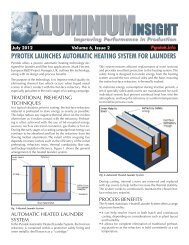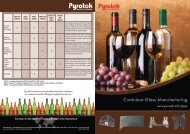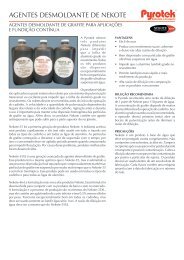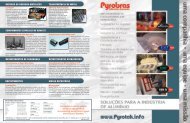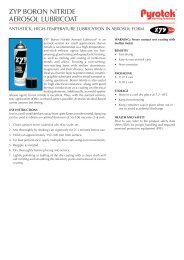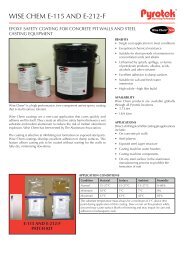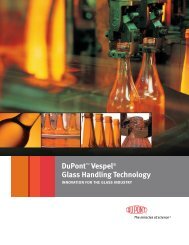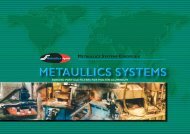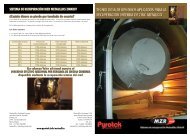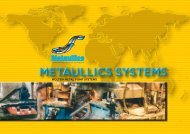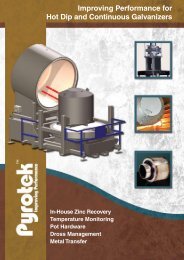GlassInsight_5-2013_.. - Pyrotek
GlassInsight_5-2013_.. - Pyrotek
GlassInsight_5-2013_.. - Pyrotek
Create successful ePaper yourself
Turn your PDF publications into a flip-book with our unique Google optimized e-Paper software.
6SAGE reports record sales in 2012SAGE Electrochromics Inc., aMinneapolis, Minnesota, USAbasedmanufacturer of dynamicwindow glass, reported record salesand opened a new facility in 2012.SAGE’s signature product is electronicallytintable glass, calledSageGlass ® , that controls heatgain and glare in a building,optimises daylight and increasesenergy efficiency while preservingSageGlass was installed at Pennsylvania,USA’s Kimmel Center to make its event spacecomfortable year-round. Photo courtesy of SAGE.the outdoor view, the company says. SageGlass, an alternative to mechanicalwindow shades or blinds, can reduce a building’s cooling load by 20 percentand HVAC requirements up to 30 percent.Recent commercial projects that have used SageGlass include the KimmelCenter for the Performing Arts, in Philadelphia, Pennsylvania; the University ofKansas Center for Design Research; the research facilities at the U.S. Departmentof Energy’s National Renewable Energy Lab; and the Mille Lacs Band of Ojibwetribal headquarters, all in the USA.Last year, SAGE completed construction of a 30-square-metre (324,000-squarefoot)facility in Faribault, Minnesota, that produces dynamic glass in largearchitectural sizes in high volumes, the company says.Meanwhile, SAGE and architectural glass fabricator, Viracon, have entered intoan agreement in which SAGE markets and sells a line of SageGlass productsthat incorporate a Viracon exterior. “This product integration will give customersmore aesthetic options for solving a variety of glazing challenges in their buildingprojects,” SAGE said in a press release.Also last year, France-based materials company Saint-Gobain purchased SAGE,making it a wholly owned subsidiary.“We are firing on all cylinders,” said John Van Dine, SAGE founder and CEO, ina press release. “The technology is proven. Interest in SageGlass from architectsand building owners has never been stronger. We’re ramping up high-volumeproduction, and we’re supported by the global research and resources of theworld’s greatest building materials company.”P&G achieves zero manufacturingwaste at 45 of its plants worldwideProcter & Gamble (P&G), a Cincinnati,Ohio, USA-based manufacturer ofhousehold products, cosmetics andother goods, recently announcedit has achieved its goal to send lesswaste to landfills by producing zeromanufacturing waste at 45 of itsfacilities worldwide.Over the past five years, P&G’s effortto find worth in its waste has createdover USD$1 billion in value, says thecompany.The company asserts that 99 percentof materials entering its plants leavesas a finished product or is recycled,reused or converted to energy. P&Gsays it has achieved zero wastethrough quality assurance, packagingreduction, compaction and recyclingefforts.“There are well-defined systems forrecycling materials like paper, plasticand glass, but our product portfoliois incredibly broad, resulting in adiverse set of waste streams to findsustainable solutions for,” ForbesMcDougall, head of P&G’s globalzero manufacturing waste program,said in a press release. “We focusedon finding solutions for our toughestwaste streams at our largest sites. …We’re now seeing new sites achievezero manufacturing waste to landfillnearly every month.”P&G has operations in about 75countries.Publisher<strong>Pyrotek</strong> Inc.9503 E. Montgomery Avenue, Spokane Valley, WA 99206 USAwww.pyrotek.infoContact-Sandra Hoskingemail—editor@improvingperformance.comThis document is for information purposes only. The information contained in thisdocument has been compiled from sources believed to be reliable. While every efforthas been made to ensure that the information is correct and that the views are sound,Glass Insight cannot be made liable for any loss, no matter how it may arise.Glass Insight is produced by <strong>Pyrotek</strong> Inc. for its customers.Copyright <strong>2013</strong>. All rights reserved.nampak to invest in upgradesNampak, Africa’s largest packaging company, plans to invest R1.6 billion(USD$174 million) in two of its businesses that produce bottles and cans for thebeverage market.The South Africa-based company will invest nearly R1 billion (USD$109 million)and add a third furnace at its glass-bottle business in Roodekop, Germiston,South Africa. The new furnace will improve overall manufacturing efficiency atthe plant and enable it to supply a broader range of bottles, Nampak says.Nampak also will add aluminium beverage can capacity and convert existinglines from tinplate to aluminium. It also has installed a new high-speed line atits Springs plant.“These two projects strengthen our position in the beverage can and glasspackaging sectors in South Africa and show our commitment to growing theSouth African economy,” Tito Mboweni, Nampak’s Chairman, said in a pressrelease.rawlings introduces mini-jarRawlings & Sons (Bristol) Ltd., of the United Kingdom, has introduceda 43-millilitre (1.5-ounce) mini-jar. The clear jars are produced using apercentage of high-quality white flint recycled glass cullet. They are packagedto pharmaceutical standards and are geared toward the hospitality and travelindustries. They also are suited for use as product samples or promotionalitems, Rawlings says.Lightweight continued from page 1Coca-Cola Co. introduced its Ultra Glass bottle to reduce weight and costmore than a decade ago. The bottles are 20 percent lighter and 10 percent lessexpensive than traditional contour bottles, the company says.Waste & Resources Action Programme (WRAP) launched its Container Liteinitiative in 2007, which studied how consumers responded to lightweightpackaging. “Consumers very rarely compared the gross weight of two products atthe same time when making a purchasing decision.” Coors Brewers Ltd. reducedthe weight of its 300-millilitre (10-ounce) Grolsch and Coors Fine Light bottles,saving 4000 tonnes each year, WRAP reported.WINE INDUSTRYIn 2010, more than half of USA wineries had begun using lighter weight bottles.Glass bottles, from 198 milliletres (7 ounces) to 4 litres (1 gallon) accountedfor nearly 83 percent of wine sales by volume in 2010, the Glass PackagingInstitute says. “Wine glass bottle suppliers are turning out ever-greener bottleswith an improved carbon footprint. Owens-Illinois, Verallia / Saint-Gobain, andother glass suppliers now make even lighter weight glass bottles to save onmanufacturing and shipping costs and are using more recycled glass bottles inthe manufacturing process, saving energy and reducing emissions.”USA-based Owens-Illinois Inc. (O-I), the world’s largest manufacturer of glasscontainers, launched its lightest North American wine bottle in 2010. It is 27percent lighter than a traditional bottle and weighs 340 grams (12 ounces). At thetime, Stan Gossett, Vice President and Category Director for O-I’s North AmericaWine, said, “We are proud to offer additional lightweight packaging optionsthat help customers realise higher environmental savings, while retaining thestrength and premium images for which O-I packaging is known.”Verallia introduced an eco-friendly bottle, now called Ecove, in 2009. “Thesebottles average 15 percent less weight than bottles of their comparable standarddesigns,” yet they have the same wall thicknesses. Saverglass, of France, releasedits Eco-Design range of bottles for wines and spirits in 2010, and Fetzer, aCalifornia, USA, winery launched a lightweight bottle initiative in 2008 thatreduced its carbon footprint.According to Wines & Vines, “Lighter weight bottles are here to stay, but their usemay have leveled out.” Most manufacturers offer a lighter bottle but the growthof the trend has plateaued.New Canadian rules, however, may contribute to lightweighting growth. TheCanadian government has required that manufacturers offer bottles weighingless than 400 grams (14 ounces). As of 1 January, Canada’s Ontario provinceestablished a maximum weight for glass wine bottles. Under the new rule,750-millilitre (25-ounce), non-hock wine bottles can’t weigh more than 420grams (15 ounces), which is about 20 percent lighter than the current averageweight of a standard wine bottle. For hock bottles, which are typically taller, themaximum weight is 450 grams (16 ounces).The global glass industry generates about USD$75 billion in revenues annually,First Research reports. Top exporters include Belgium, China, France, Germany,Japan and the USA. In 2011, European Union countries produced 20,800 tonnesof container glass. In Europe, glass container manufacturing volume grew 4.2percent in 2011, although volumes fell slightly in the United Kingdom. “Ifproduction volumes remain the same year-on-year, then lighter glass bottles meanthat more of them are produced and all U.K. glass container manufacturers havemade great progress in successfully reducing the weight of glass containers,”writes Theresa Green, of British Glass, in Glass Worldwide.





